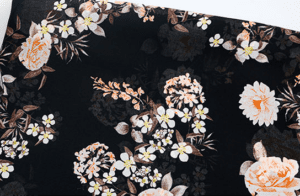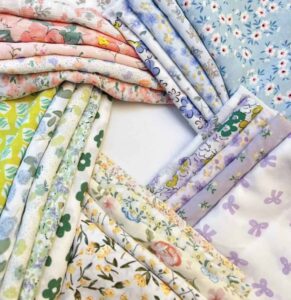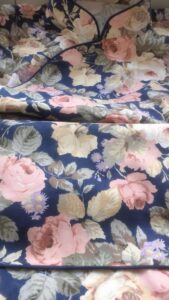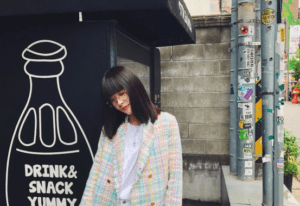China’s traditional culture is long-standing and profound, and is admired by the world. It is incumbent upon designers to research and develop a design style with Chinese characteristics, while taking advantage of advanced printing and dyeing techniques. In this article, we take the creation of an ancient costume pattern for a goblet-shaped event as an example of how to combine classical culture with modern digital printing techniques.
Wang Xizhi, a calligrapher of the Eastern Jin Dynasty, invited the literati Sun Tong, Sun Chor, Xie An and Zhi Zun to a purification ceremony at Lanting on the third day of the third lunar month in the ninth year of the Yonghe era. They had the wine cups float slowly downstream from the curved water, and whoever floated to them would write a poem, and if they could not produce a poem, they were punished with three goblets of wine. Wang Xizhi’s 324-character ‘Preface to the Lanting Gathering’, which he wrote in a single breath, has been described as ‘the best writing in the world’, and the Confucian style of goblets has been passed down to this day. In order to commemorate the goblets and to promote Chinese classical culture, the modern generation is determined to recreate the Lanting Yaji, and in the process of doing so, digital printing technology has been introduced to create a series of clothing patterns with cultural characteristics from the Wei, Jin and Northern Dynasties.
Digital printing has the advantage of being environmentally friendly and plate free, with an emphasis on personalisation. The author argues that designs that promote national culture can also take advantage of modern technology and be widely accepted by modern people. In this paper, I will analyse how classical culture and modern technology can be combined in terms of material collection, design ideas, pattern composition methods and the grasp of digital printing features.
Flower design material collection
In China, the combination of computer-aided design and digital printing has been widely Many of these designs are overly technical and neglect the ability to use this technology to develop the designer’s ability to innovate in the local culture. In this case, the design of the goblet character costume is based on a collection of motifs that are characteristic of the period, which are then modified and combined with natural patterns to highlight the unique literary qualities of the historical character.
It is clear from this study that the Wei, Jin and Northern Dynasties were a time of division and war, characterised by frequent changes of government and warfare. The artwork of this period was heavily influenced by Buddhist culture, and many of the motifs were influenced by images of flying celestial beings. Figure 1 shows a beautiful image of a flying celestial being in a print from the Northern and Southern Dynasties. Many of the decorative motifs of this period were influenced by the flying celestial form, such as the plant motif in Fig. 2, where the leaf stems flutter up at the end, echoing the flying celestial image. The plant motifs are represented by the lonicera motif, which appears in various forms in Buddhist decoration, as in Fig. 3, which shows a floral loop in a continuous decorative motif
Firstly, the plant is said to be immortal over the winter, signifying the immortality of the human soul and the possibility of reincarnation. The flowing tail represents a continuation of life. Secondly, it was influenced by painting. Influenced by the spirit of temperament valued by Gu Kaizhi in the late Eastern Jin dynasty and by the lean and ethereal style of Lu Wei’s paintings in the Southern Song dynasty, the lines are smooth and flowing, signifying ascendancy and good fortune, and having an auspicious connotation of longevity. Thirdly, the Buddha, the Bodhisattva and the flying celestial being in the wall paintings need to have flowing plants in harmony with them, expressing the realm of freedom and liberation. The Wei and Jin dynasties drew from the ‘air, rhythm, form and spirit’


The work’s connotations begin to be studied from the perspective of the artist. In terms of image, the emphasis on resemblance has evolved from that of form to that of spirit, from the pursuit of external resemblance to the pursuit of internal aesthetic characteristics. This sense of ease and liberation is called ‘qi’. The combination of plants and qi is referred to as the botanical cloud pattern, which is often made up of smooth, swirling lines. The result is the swirling, soaring, melodic beauty of the lonicera.
During the Wei-Jin and Northern and Southern Dynasties periods, the cloud-qi motifs of the Eastern Han period were mainly continued, with a variety of forms, including a variation on the cloud-qi motif of a mountain range with animals looming out of it. The cloud-qi pattern can also be combined with wind, fire or plants, as in figures 1-7, where it is combined with the plant dogwood, forming a botanical cloud-qi pattern. The rhythm and rhyme of the motifs are emphasised, giving the viewer a sense of flight. Figures 4 and 5 show abstract geometric motifs that were popular at the time and could be used as elements of collar trims to express a simple, yet sophisticated style.
It can be seen that during the Wei, Jin and Northern Dynasties, the aesthetic ideology of ‘clear and elegant’ was advocated, and the decoration was surrealist in style, with more abstract motifs and handsome, flowing lines as the basic artistic language. Influenced by Buddhist art, its shape has developed towards a slender, serene form with transcendent ideas. In the process of collecting, the designer needs to not only extract the elements, but also study their compositional characteristics, so that the historical quality of the motifs is not lost, regardless of the modern design techniques used.
Handling of the material
The composition of the design is one of the main points of difference between digital and traditional pattern design. Traditional patterns are generally composed of individual patterns, bifurcations and quadrilaterals, which consist of a single unit of pattern variation in a wide variety of combinations. Digital printing can be used to refine and distort the collected material using computerised design software, to create new Chinese floral patterns.
The pattern is designed using imagery, emphasis, decomposition and superimposition. For example, according to Fig. 6 and Fig. 7, I selected some of the details and studied the trend of the cloud pattern, and redesigned the individual pattern using coreldraw and PS software as shown in Fig. 8.

If it still looks sharp and the resolution is not less than 200dpi, then the individual pattern is acceptable. This individual pattern is then rotated and combined to form Figure 9, and Figure 9 is then continued to form Figure 10. Figure 11 shows the detail softening of Figure 10 by applying “Filter – Blur – Surface Blur”, moving the Radius and Threshold sliders back and forth to the appropriate level, and “OK”. After ‘OK’, sharpen the detail by running ‘Filter – Sharpen – USM’ and moving the amount and radius sliders back and forth to get the right amount of detail in the brushstrokes. The sliders for the amount and radius are moved back and forth until you are satisfied with the detail of the brush strokes. After strengthening the real and imaginary changes, Figure 11 was combined with Figure 16, and the colour tone was adjusted to make the complete flower pattern on the left of Figure 14, and the real effect on the right of the main character Wang Xizhi, showing the master’s style and elegant literati temperament, with a white translucent cardigan, which stands out from a distance in a line of famous scholars, achieving the purpose of highlighting the main character. The pattern is designed using a combination of decompositions.
Extract elements from the dogwood cloud pattern (Fig. 7) (Fig. 12) and use PS software to thicken and distort the image, enhance the shadows and brighten the highlights, using Image – Adjustments – Shadows/Highlights, to create a three-dimensional image (Fig. 13). To resize the stone pattern in Figure 17 and make the stone base a continuous pattern, use PS software to adjust the colour palette to a suitable blue colour, stitch it in a continuous pattern and select a flower back, then resize the image in Figure 13. The image in Fig. 13 is varied in size and colour and combined with the stone pattern. The overall pattern is shown on the left in Fig. 15, and the garment is shown on the right in Figs. 2-8. The blue colour is the main colour, signifying wisdom. The blue colour is the main colour, signifying wisdom, and the fish-like pattern of free air and clouds swimming on an ocean of stone, signifying the far-reaching heart of a famous scholar, who could be between heaven and earth, reflecting the designer’s unyielding desire for life and freedom of flight.
Digital printing characteristics to grasp
As a new high-tech printing process in recent years, digital printing is not only rich in colour, smooth printing levels, and the whole process is smooth and natural, with a photographic style, printed products can clearly and realistically show the complexity and fineness of the pattern, providing people with a new visual experience. As digital printing technology can use digital patterns, after the computer for colour measurement, colour matching, printing, digital printing products can theoretically reach 16.7 million colours, especially in the colour gradient, cloud pattern and other high-precision pattern printing. Compared to traditional printing
It is much less likely to be imitated. As the saying goes, “You see colour from afar and flowers from close up”, the first thing people notice is the colour. When we look at a garment, the first thing we notice is the tone of the colour, and then we get a closer look at the details of the pattern and the texture of the garment, so it is important to get a good idea of the overall tone of the pattern. This is where the background textures are particularly important, as they can fully reflect the characteristics of the digital print pattern, and take advantage of the particular strengths of the digital print technology to reflect the overall feel of the garment without losing the individual beauty of the garment.
The costumes of the historical figures in the Goblet Goblet event were created using the advantages of digital printing in three main ways, showing the freedom and flexibility of the combination of costume and pattern.
Digital pattern features
Digital printing technology has expanded the visual field of pattern effects, such as three-dimensional effects, movement effects, simulated textures, light effects and psychedelic effects, adding vividness to the design of apparel fabrics. Figure 16, for example, is based on the imagery of the wind blowing through the city, which illustrates the noble character of a famous man in a turbulent war-torn world.
Designers can use PS software to create abstract and abstract designs for different characters by adding naturalistic underlays based on elements from the Wei, Jin and Northern Dynasties, and by shaping, blending, and changing the reality of the characters.
The complete flower pattern. The first advantage of digital printing over traditional printing is shown in the design artwork.
Seamless splicing technology
Traditionally, garments with a continuous pattern are made by cutting a complete piece of printed fabric and sewing it together. This method of production results in significant misalignment of the pattern at the seams of the garment and the pattern is not continuous. Seamless stitching, on the other hand, can be done with image editing software so that the garment pattern can be perfectly stitched together at the seams, giving it a seamless appearance. The line between A and B shows the seam that needs to be cut. Figure 21 shows the pattern of the cut pieces according to Fig. 20, with the sleeves as separate pieces, each with the corresponding seam allowance, while the pattern already arranged in Fig. 20 remains in place. At the sleeve seams, the pattern is continuous and unbroken. Similarly, the men’s garment is cut with a centre-back seam, and the men’s garment is shown below in Fig. 22 with a continuous pattern at the centre-back seam, which is also very complete. Seamless stitching is the second major advantage of digital printing over traditional printing.
Digital printing positioning technology
The design of this garment fabric also involved the use of digital print positioning techniques. The steps are as follows: Firstly, the pattern is created using the garment CAD software, as shown in Figure 20, and then made out of the fabric and tried on by a real person to determine the basic positioning and orientation of the pattern. Fourthly, the actual image data is recalculated using the actual grid information of the print area obtained in step 3 and the corresponding theoretical grid information; Fifthly, the actual image data obtained in step 4 is perfectly combined with the garment cut-out and uploaded as print data to the controller of the inkjet device; Sixthly, the controller of the inkjet device reads in the actual image data and starts printing the official garment cut-out. As shown in Figure 23, the digital printers position the cut pieces for printing, prepare them for thermal transfer printing, then cut the fabric and make them. Figure 24 shows how the garment will look once it has been made. Digital printing positioning technology is the third advantage of digital printing over traditional printing.
Concluding remarks
Digital print is unrestricted and full of imagery. It allows the designer’s creativity to run wild, interweaving many seemingly unrelated elements and presenting a mysterious and unpredictable world of illusion. Therefore, I believe that the ultimate test of digital print pattern design is a designer’s ability to think abstractly. Firstly, the intention of the design must be higher than the design technique itself. Only when the design is based on the promotion of the classical culture of the nation will the designer have the spirit to work hard. Secondly, design is not a matter of following a trend. Only by working hard to collect materials, clarifying the objectives of design, learning from its cultural ideology and grasping the laws of nature can one design a work that is truly personal to oneself.
























